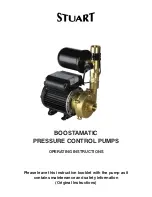
308996
9
Operation/Maintenance
Flush Pump Before First Use
The pump is tested with lightweight oil, which is left in
to protect the pump parts. If the fluid you are using
may be contaminated by the oil, flush it out with a
compatible solvent. See Flushing on page 10.
Starting and Adjusting Pump
Before starting, fill wet cup 1/3 full with TSL or compat-
ible solvent.
1.
Remove tip guard and spray tip from gun. Refer to
gun manual.
2.
Close air regulator (F).
3.
Close bleed–type air valves (E and K). Connect
airline (H) to bleed–type air valve (E).
4.
Check that all fittings throughout the system are
tightened securely.
5.
See Fig. 2. Connect the suction hose (T) to
pump’s fluid inlet. Place tube into fluid supply.
Do not stretch hose tight; let it hang as shown in
Fig. 2, to assist fluid flow into pump.
6.
Hold metal part of gun (S) firmly to side of
grounded metal pail and hold trigger open.
7.
Open pump’s bleed-type master air valve (E).
8.
Slowly turn regulator knob clockwise increasing
pressure until pump starts.
9.
Cycle pump slowly until all air is pushed out and
pump and hoses are fully primed.
10. Release gun trigger and engage safety latch.
Pump should stall against pressure.
CAUTION
Do not allow the pump to run dry. It will quickly
accelerate to a high speed, causing damage. If your
pump is running too fast, stop it immediately and
check the fluid supply. If the container is empty and
air has been pumped into the lines, refill the con-
tainer and prime the pump and the lines, or flush and
leave it filled with a compatible solvent. Eliminate all
air from the fluid system.
11. With pump and lines primed, and with adequate air
pressure and volume supplied, pump will start and
stop as you open and close gun.
WARNING
COMPONENT RUPTURE HAZARD
To reduce the risk of overpressurizing
your system, which could cause compo-
nent rupture and serious injury, never
exceed the specified Maximum Incoming Air Pres-
sure to the pump (see the Front page of this
manual).
12. Use air regulator (F) to control pump speed and
fluid pressure. Always use lowest air pressure
necessary to get desired results. Higher pressures
cause premature tip and pump wear.
WARNING
SKIN INJECTION HAZARD
The system pressure must be manually
relieved to prevent the system from
starting or spraying accidentally. Fluid
under high pressure can be injected through the
skin and cause serious injury. To reduce the risk of
an injury from injection, splashing fluid, or moving
parts, follow the Pressure Relief Procedure
whenever you:
D
are instructed to relieve the pressure,
D
stop spraying,
D
check or service any of the system equipment,
D
or install or clean the spray tips.
Install the Spray Tip
WARNING
To reduce the risk of serious injury whenever you
are instructed to relieve pressure, always follow the
Pressure Relief Procedure on page 8.
Relieve the pressure by shutting off air valve and then
trigger the gun. Install the spray tip and tip guard as
explained in your separate gun manual.










































